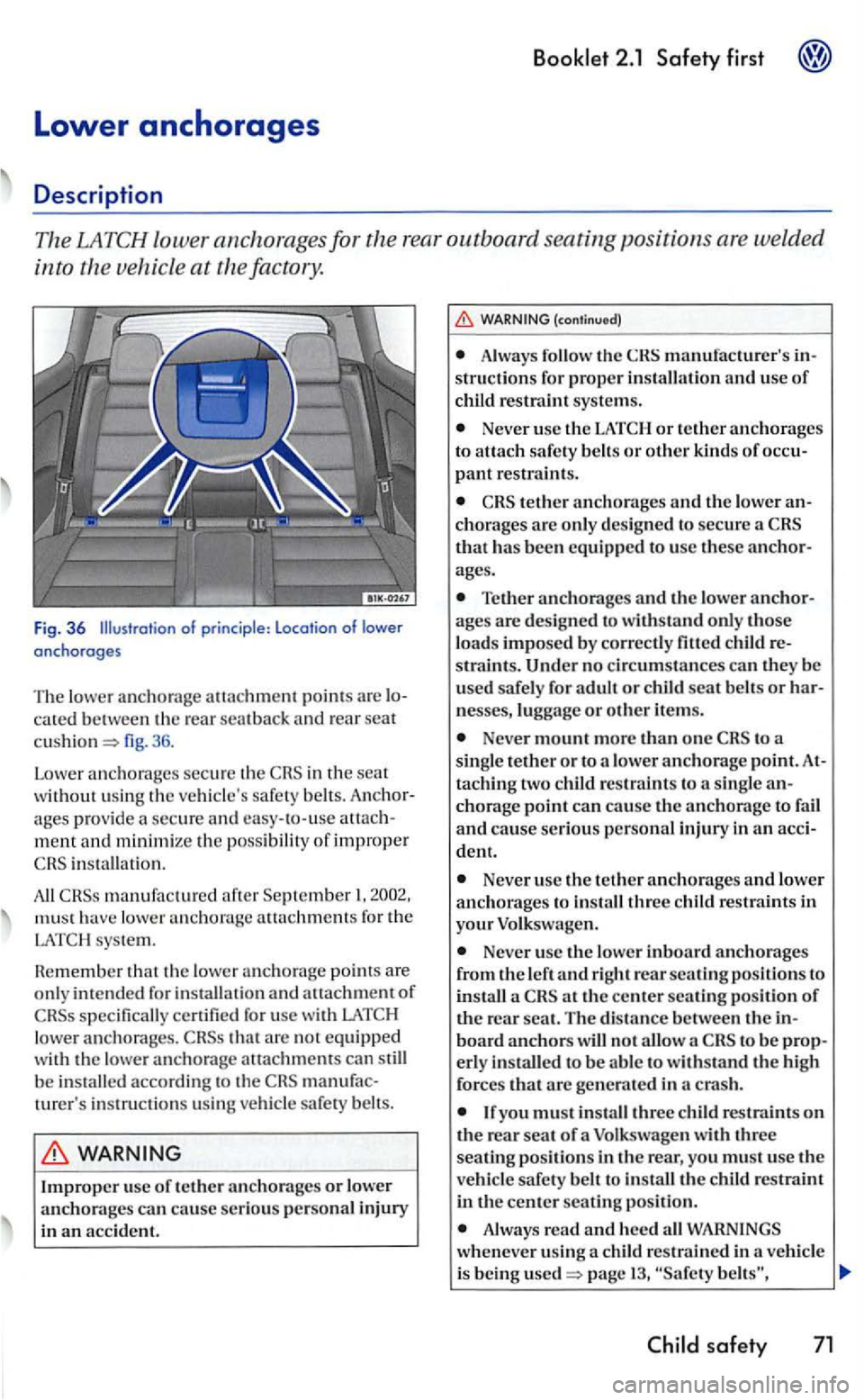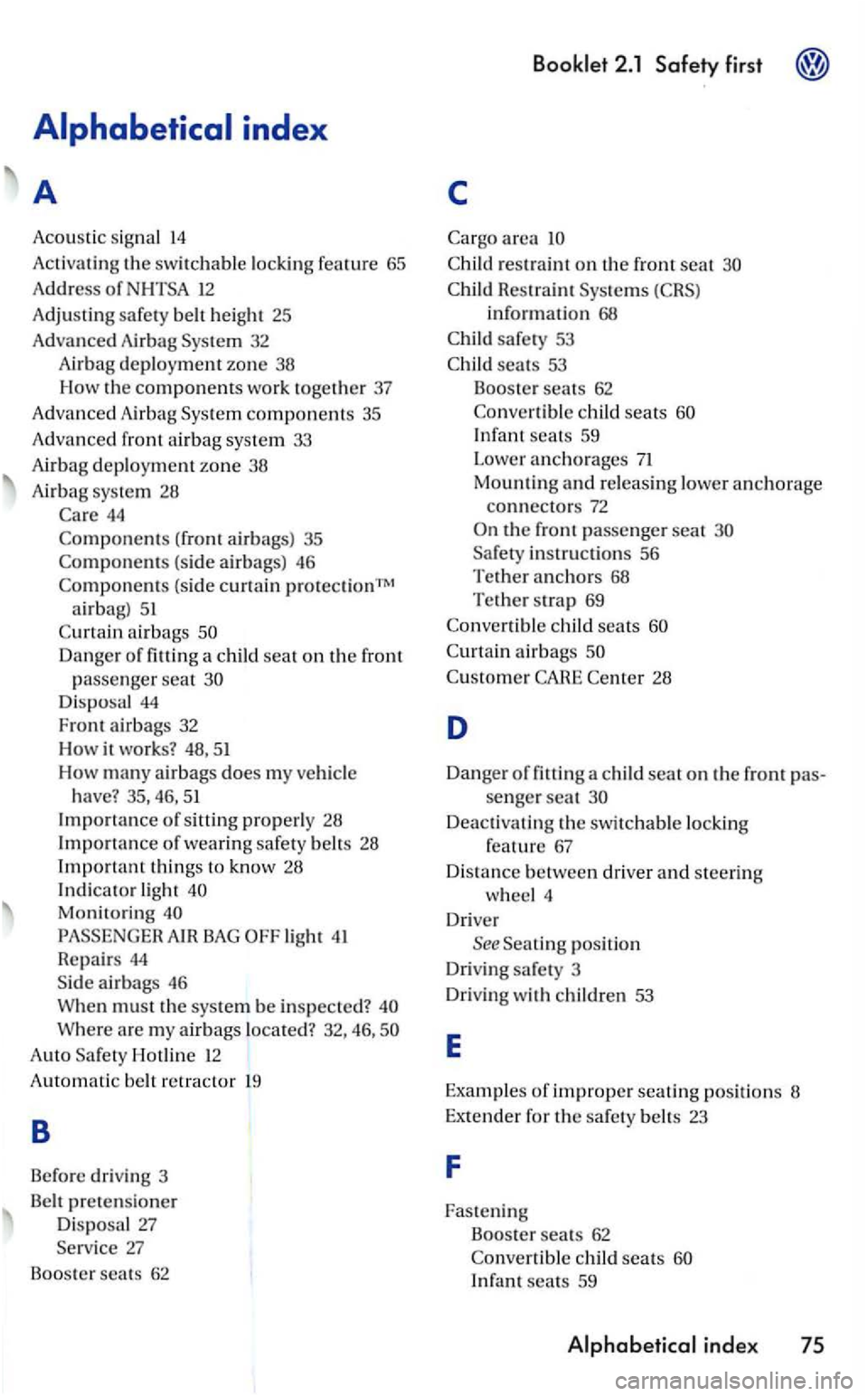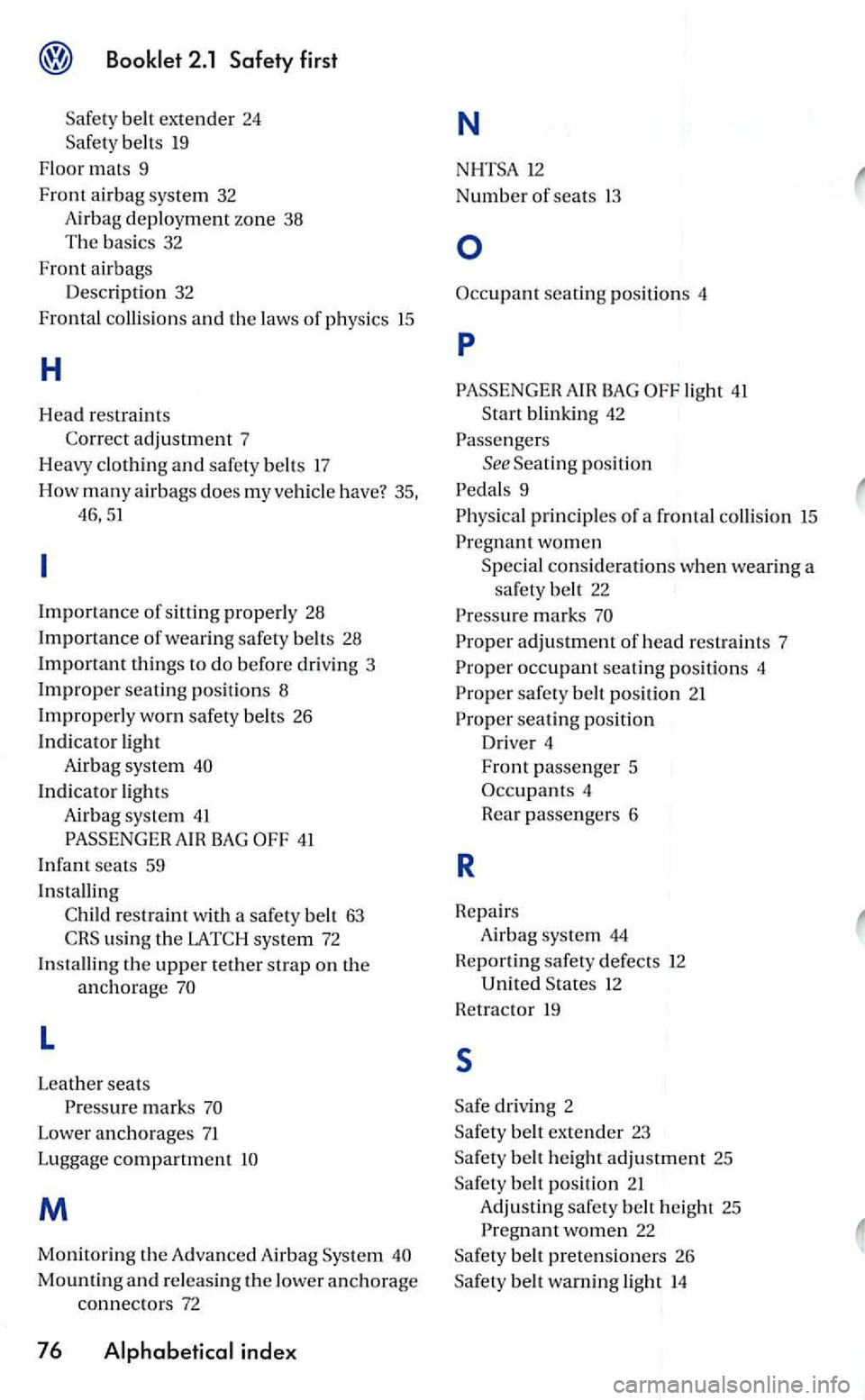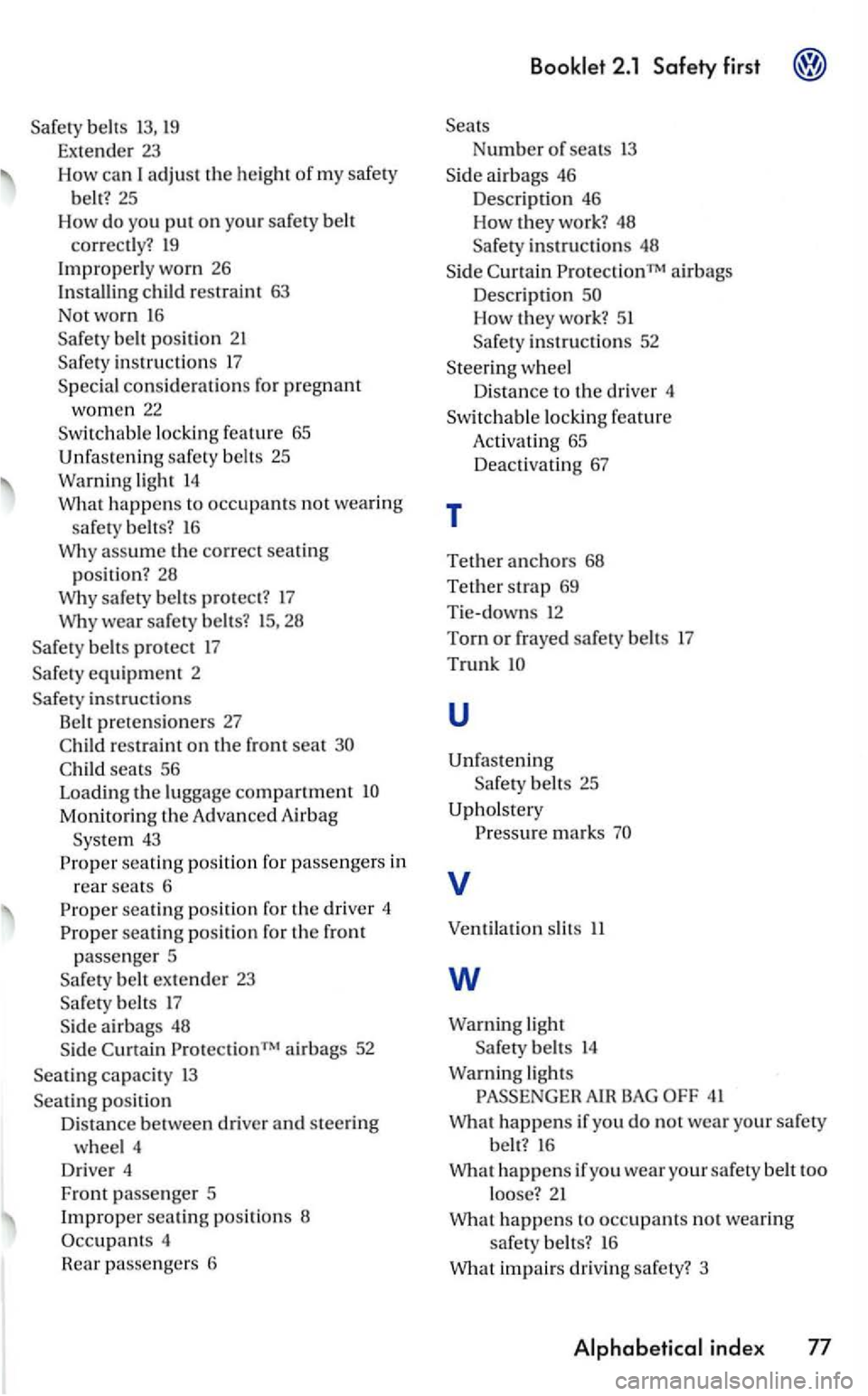2005 VOLKSWAGEN GOLF belt
[x] Cancel search: beltPage 159 of 444

Booklet 2.1 Safety first
T he lower an chorage au ac hme nt poi nts are lo
ca ted between the rea r sea t ba ck and rear seat
cushion fig . 36 .
Lower anchor ages sec
ure the in the seat without using th e ve hicle's safety belts. Anc hor
ages provide a secure and easy- to-use attach
m ent and minimi ze the poss ibilit y of improper
manufa ctured after Sep te mber mu st lower allachment s fo r th e sys te m.
Hem ember th at th e lower anchorage points are
only intended for installation and all achment of
lowe r a nchorages. that are not equipped
w ith the lowe r a nchorage auachrnents can still be installed accord ing to the m anufac
turer' s inst ruc tion s using vehicle safe ty belts.
(continued)
Always foll ow the C HS m anufacturer's in
s tru ction s for prop er in sta llation and use of child restraint syste ms.
Never usc the or te ther an chorage s
to attac h safe ty belt s or other kinds of occupant restraint s.
tethe r anch ora ges and the lowe r anchorag es arc only des ig ned to sec ure has be en equipp ed to usc these anchor
a ges.
Tether anchorages and the lowe r an ch orage s are designed to withstand only those loads imposed by correc tly filled child re
straints.
Neve r mount more than one to a
single te ther or t o a lowe r a n chora ge point. Attaching two child restraint s to a sin gle an chorage point ca n cause the anchorage to fail and cause serious person al injury in an accident.
N eve r u sc the tether anch ora ges and lower anch orages to install three child restra ints in
you r Volkswag en.
Never use the low er inboard anchorages
from the left and right rear se ating position s to
in sta ll a at th e ce nter sea ting position of rear sea t. T he di stance between th e in board anchors w ill no t allow a to be prop
e rl y i nstall ed to be abl e to with stand the hi gh
f orces that are generated in a cras h.
you must in stall three child restra ints on the rea r seat o f a Volk swagen with three
seating positions in the rear, you must u se the vehicle safety belt to install th e c hild restraint in the center seating position.
Always read and heed all WAR NINGS
wh enever u sin g a c hild res train ed in a vehicl e
i s being used page
safety 71
Page 161 of 444

-both straps wit h hook-on con
n
ect ors on the secu re ly to the lower
a n ch orages.
- P ull str ap s tig
ht foll ow ing th e man
ufacturer's instr uctio ns.
-Release or deploy th e ch ild rest ra in t
tether strap.
- Guide th e
upper tether strap under th e
rea r
head restraint (ra ise the head restra int
if n ecessary).
- Att
ach th e te ther s trap anch orage hook
int o th e o pe
ning of th e te ther a n ch o rage.
- Pull on
both of the adjustable straps on
th e
to make cer
t ain it's secure a
nd properl y attached .
Relea sing
- Loose n th e te nsio n on the stra p f ol
l
owing t h e manufacturer's in stru c
t i
ons.
- Dep ress the sprin g catch on th e hoo k.
- Hold th e s prin g
catch in th e dep ressed
p os ition .
- Move th e h
ook in direct ion of th e ve
hicle floo r so that the re is en o ug h space to
r e lease th e co
nnecto r f ro m th e lowe r an
c h o rage.
Booklet 2.1 Safety first
-Release the te th er str ap
WARNING
Impro pe r u sc of th e sys te m can in
c re a se the risk of serio us personal inju ry and death in an accid ent.
Th ese anchors were developed sole ly fo r seats usin g the sys te m .
Neve r attac h oth er child seats,
A lways make sure th a t the yo u hear whe n l atc hin g th e seat in place.lfyou d o not
hear f orward and hit th e int erior of the ve hicle, or
b e e jecte d from the ve hicl e.
WARN ING
Im proper in sta ll ati on of restra in ts
A lways manufacturer's
as the
l o w er anch orages or safety belt s in your ve
Always read and heed th e i mportant infor
m ati on an d about safety and the in sta ll ati o n of
se lectio n, in stalla tion and
use:
N
HTSA advises that the best child safety seat is
t h e o ne that fits your c hil d and fits in your veand that you will use correct ly and consis
tent ly.
Try befo re you b uy!
Nat ional High way Traffi c Admini stration
Tel.: (888) www.nhtsa.do t.gov
Nati onal Tel.: (202) 662-0600
www.safekids.o rg
www.ca rseat.o rg
safety 73
Page 163 of 444

32
A ir
bag deployment zone 38
How the
components work together 37
Adva n
ced Airbag components 35
Adva nced front airba g sys tem 33
Airbag deployment zone 38
Airbag system 28
Care 44
Components (front air bags) 35
Components (side airbags) 46
Components (sid e curtai n protectionTM
a irbagl Curtain a irb ags
light Repa irs 44
Hotline 12
Automatic belt retractor 1 9
8
Before driving 3
Be lt
pretensioner
Disposal 27
27
Booster seats 62
first
c
Cargo area
Infant seats 59
Lower
anchorages 71
Mounting and releasing lower anchorage connectors 72
the front passenger seat
inst ruct ions 56
Tether an chors 68 Tether strap 69
Convertibl e child seats
Curtain airb ags
position
Driving safety 3
Driving with ch
ildren 53
E
Examples of improper seating posit ions 8
Extender for
the safety belts 23
F
Fastening
Booste r seats 62
Co nvertible chil d
seats Infa nt seats 59
Page 164 of 444

belt extender 24
Safet y belt s 19
Floormats 9
Front airbag system 32
Airbag deplo ym ent zo ne 38
T he basics 32
Front airbags
Descript i
on 32
Fronta l co llisi
ons a n d the laws of phys ics 15
H
Head restraints
Correct adjustment 7
Heavy clothing
and safety belt s 17
How m
any airbags does my vehi cle have'? 35,
46,51
Importance of sitting properly 28
Importance of wearing safet y belt s 28
Important things to do befor e driv ing 3
Improper seating posit ions
Improperly worn safety belts 26
I
ndicator light
Airbag system
Indicator ligh ts
Airbag system 41
AIR BAG
u sing the LATCH sys tem 72
I
nstalling the upper tet her strap on the anchorage
L
Leat her seats
marks
Lower anchorages 71
Luggage compartment
M
Monitoring the Advanced Air bag Syste m
Occupant seating positions 4
p
light 41 Start blinking 42
principles of a frontal collision 15
marks
adjustment of head restraints 7
occupant seating pos itions 4
safety belt position 21
driving 2
Page 165 of 444

belts 13, 19
Extender 23
How can I adjust the heigh t o f my safery
belt? 25
How
do you put on you r safery belt
correct l
y? 19
Improperly worn 26
Installing child restraint 63
Not worn
16
belt position 21
instructio ns 17
Specia l consid erations for pregnant
women 22
Switc hab le locki ng feature 65
Unfa stening safe ty belt s 25
Warning light
14 What happen s to occupants not wearing
safety
belt s? 16 Why assume the co rrect seatin g
position? 28
W hy safery belts protec t? 17
Why wear safery belts? 15, 28
belts protect 17
Monitoring the Advanced Airbag
43
seatin g positi on for the driver 4
seating position for the front
passenger 5
belt extender 23
Curtain airbags 52
Seating capacity 13
Sea ting position Distance between driver and steering
wheel 4
Driver 4
Front
passenger 5
Improper seat in g positi on s
4
Rear
passe ngers 6
air bags 46
Description 46
Ho w
they work?
in structio n s 48
airbags
Desc ripti
on
How they work? 5 1
instructions 52
Steer ing w hee l
Distance
to the driver 4
Sw itchable locking f
eature
Activating 65
Deactivating 67
T
Tether anchors 68
T
ether strap 69
Tie -
downs 12
Torn or f rayed safety bel ts 1 7
Trunk
u
Unfasten ing
belts 25
Upholstery
v
Ventil ation slit s ll
w
Wa rning light
belts 14
Wa rnin g lights
Page 176 of 444

3.1
M eaning o f warning lights
Brake
pads worn-contact your authori zed Volkswagen dWindshield was her fluid too lowealer or qualified workshop
Windshield washer fluid level too low
Fuel level too low (reserve)-Hefuel as soon as possibl e
Engin e oil press ure too low-engine
off and ch eck en gine oil leve l
Do ors open
Make su re tha t all the doors completely cl osed (to the second catc h ).
lid open
Engine oil level too low-
Warning and indicator light s in the
Meaning of warning lig h ts
Dep ress ped a l
Airbag system malfunction-contact your au -
thorized Volkswagen dealer or qualified work-shop
Airbag disabled
Belt prete n sioner system malfu nction-contact your authorized Volkswagen dealer or qualified workshop
En gine hood open
Fasten safet y belts!
Malf unction in anti-loc k brake syste m -contact
o r your auth orized Volk swagen dealer or qualifi ed
work shop
Flashing: Electroni c Stab iliza tion in operation or Hegulat io n in op-eration Illuminated: or m alfunct ion or
sw itched off
6
and
3 .2 chapter and
3.2 and chapter the
booklet 3.2 chapter
page33
page35
3.2 and Advice" , chapter
page 88 page 85
2.1 fir st" , c hapte r
chapter "Airbag
booklet2.1
booklet 3.2 and Adv ice",
chapter
2. 1 first", chapter
bookl et3.2 and
bookle t3 .2 and A dvice" . chapter
Page 225 of 444

Booklet 3.1
passe nger's seat can
b e adju ste d in many ways to suit the physical
need s of the vehicl e occ upants. position is
very important for:
fast and easy operat ion of all control s on the instrument panel,
safe driving ,
optimum prote ction from the s afet y belts
and airb ag booklet 2.1
Driv ers or passengers who are unbelted, out of position or too close to the airb ag can be seri
ously injured or killed by an airbag as it unfolds. To help reduce the risk of serious personal injury:
Always adjust th e driver's seat and the steeri ng whe el so that there are a t lea st in ches (25 em) betwe en you r brea stbone and the ste erin g w heel.
Always hold the steering wheel on the out
s ide of th e s teering wheel rim with your hands at the 9 o'clock and 3 o'clock position s to he lp
reduce the risk of personal inju ry if the driver 's airbag inflates.
Never hold the steering wheel
Passengers must always sit in an upright position and never lean agains t or pl ace an y
(co ntinued)
part of their body too close to the area where the airbags are loca ted.
Alway s make sure there are at least inch es (25 em) between instrument panel.
Eac h passenger must always sit on a sea t of their own and prope rly fasten and wear the safety belt belon ging to that scat.
Before driving, always adjust the front
seats and head r estraints properly.
Never adju st th e sea ts while the vehicle is
moving. sea t may move unexpec tedly and yo u could lose control of the vehicle.
Always keep your feet on the floor in front of the sc at. Never rest on tl1e in strument panel, out of the window, etc. The airbag
s ystem and safety belt will not be able to pro
te ct you properly and can even increase the
ri sk of injury in
Never drive with backres t reclined or tilted far backJ The the backres ts are t ilted back, greater risk of injury due to
incorrect positioning ofthe safety belt and im
proper seating position.
b elts only offer maximu m prot ec
tion when the se atback is securely lat ch ed in
Children must alway s ride in child seats.
Seats and storage 55
Page 228 of 444

adjustable front seats
fig. 52 are arranged in
Adjusting the seat forward and
backward
-up the lever and move the seat
ward or
- Release the lever and slig htl y move
the seat until it la tches into place .
seat bock forward and
backwards
-To fold forward th e seat back, pull tl1e
(only 2-door vehicles) up and fold
th e
seatback At th e same time you
can slid e th e seat to th e front to make entry
into t he bac k seat of the vehicl e easier.
- To fold backwards the seat back, first
s lide the seat completely back, then pull
th e up and fold th e seat back
W here appl icabl e
58 and storage
Adjusting the support12l
-Take your weight off the backrest and
turn the to adjust the
lumbar support.
Adju sting the backrest
- Take your weight off the backrest and
turn the
up or down to raise
or lower the seat.
T he curvature of the cu shioned area is mined by the senings made in th e lumbar gio n. This s up pons the natural curvature of the spine ve ry effect ively.
WARNING
Drivers or passen gers who are unbelted, out of positio n or too close to the airbag can be
in is seat adjustment so on page 55 .
WARNING
Never adjust the seats whil e th e ve hicle is
moving. seat may mov e unexpected ly
a nd you could lose control of the vehicle.
To reduce the risk of personal injury in an accide nt, front seat passengers must n eve r
ride in a moving ve hicl e with the seatback
jury from an out of position safety belt.
when adjusting the seat for height or in the far-and-aft di rec tio n. Adjusting th e